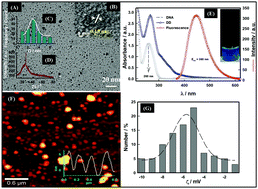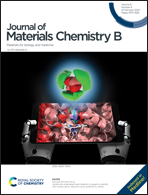Multifunctional, fluorescent DNA-derived carbon dots for biomedical applications: bioimaging, luminescent DNA hydrogels, and dopamine detection†
Abstract
Here, we describe the synthesis of 2–3 nm, hydrophilic, blue fluorescence-emitting carbon dots (C-Dots, made using a DNA precursor) by the hydrothermal route from the gelling concentration of 2% (w/v) DNA. These dots exhibited highly efficient internalization in pathogenic fungal cells, negligible cytotoxicity, good PL stability, and high biocompatibility, thus demonstrating their potential as nanotrackers in microbial studies. Bioimaging was performed using Candida albicans as the representative for microbial pathogens. The novelty of these dots is that they formed fluorescent nanocomposite hydrogels with the same DNA much below the gelation concentration (1% w/v) and the tunable gels possessed strength between 20 and 80 Pa with the corresponding gelation temperature Tgel between 40 to 50 °C. The network density and gelation free energy data supported the superior crosslinking ability of these dots. The as-prepared hydrogels can replace the existing toxic quantum dot-based hydrogels for drug delivery. We also demonstrated the use of a DNA hydrogel-fabricated working electrode (DNA-C-Dot/ITO electrode) for the biosensing of dopamine. Our electrochemical biosensor had a detection limit of 5 × 10−3 mM for dopamine. These multifunctional, fluorescent C-Dots and hydrogel after suitable conjugation or loading with molecules and drugs hold promising potential for further exploitation in bioimaging, targeted drug delivery, wound healing, and biosensing applications.



 Please wait while we load your content...
Please wait while we load your content...